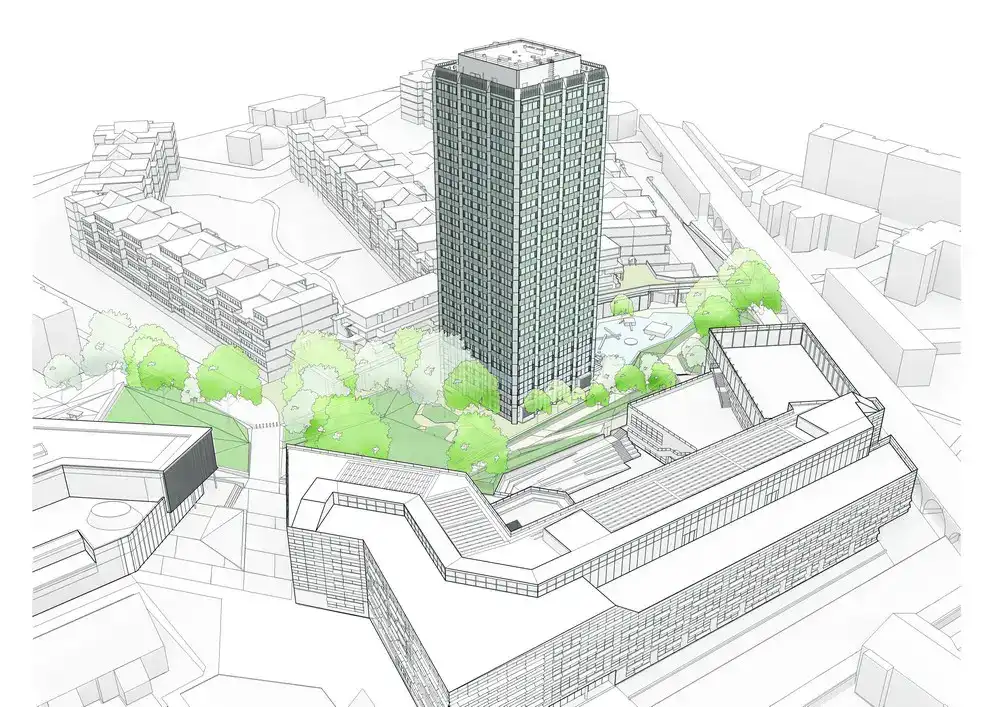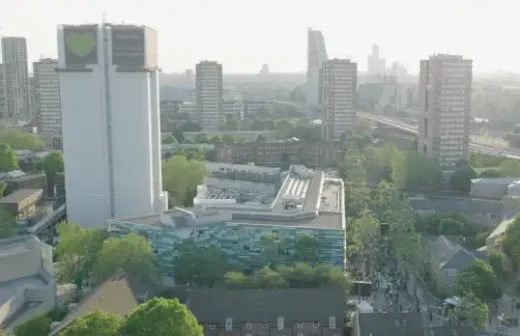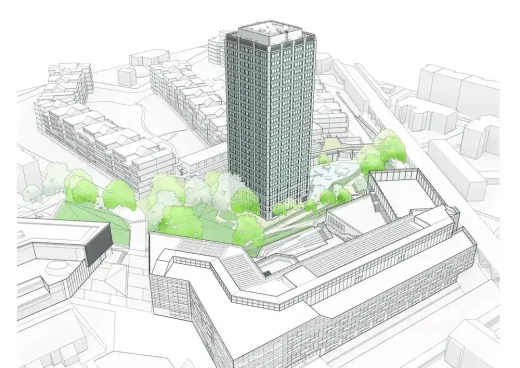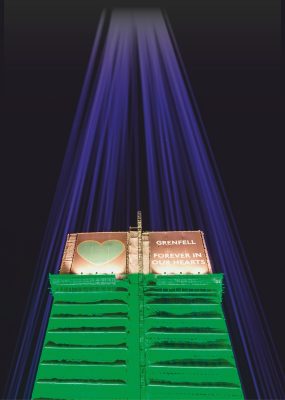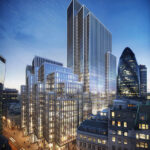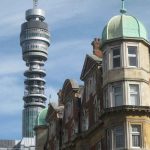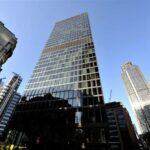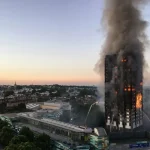Grenfell Tower memorial design team selection process launch, West London architecture competition
Grenfell Tower memorial design team selection process
22 + 21 January 2025
Grenfell Tower Memorial Commission announce the memorial design team shortlist:
Grenfell Tower Memorial Commission
Grenfell Tower Memorial Commission announces memorial design team shortlist
• The independent Grenfell Tower Memorial Commission and Royal Institute of British Architects (RIBA) have today announced the five shortlisted teams that are competing for the chance to design the future memorial on the site of Grenfell Tower.
• The shortlisted teams will now go through to an extensive second round of evaluation, including meetings with bereaved families, survivors and the immediate community that live close to Grenfell Tower.
• The winning design team is to be selected in summer 2025.
The Memorial Commission received strong applications from 28 multi-disciplinary design teams, featuring architects, landscape architects, community engagement specialists and other disciplines. A robust evaluation and moderation process was undertaken of those applicants to reach a shortlist that should have the right skills, capability and awareness of the Grenfell tragedy. Significant due diligence checks were also carried out to make sure that any team, organisation or individual potentially working on the memorial does not bear any potential responsibility for the tragedy.
The Memorial Commission has announced today that the five shortlisted design teams are (in alphabetical order):
• Curl La Tourelle + Head Architecture
• Freehaus
• George King Architects x Grow to Know
• New South
• Office Sian
This is a hugely significant step in the Memorial Commission’s journey to create a bold, fitting, and lasting memorial to remember the 72 victims who lost their lives in, and those whose lives were forever changed by, the devastating Grenfell Tower fire.
Over the next six months, the shortlisted teams will be asked to demonstrate their relevant, professional and specialist expertise including architecture, landscape architecture, and structural and mechanical engineering. Teams must also present their strong experience of working collaboratively with communities.
With direct input from the Grenfell community, the final team is expected to be selected and announced in summer 2025. It is anticipated that the memorial design should be sufficiently developed, in partnership with the community, to allow for a planning application in late 2026.
The Memorial Commission launched its international design team selection process in July 2024 and called on the design industry to put forward its best, most innovative and thoughtful teams. This followed the Commission’s publication, in November 2023, of its second report, detailing the Grenfell community’s wishes for a permanent memorial. The report also called on the government to honour its earlier commitments and to fulfil its moral duty to deliver all sixteen of the Commission’s recommendations.
The Memorial Commission has written out to the bereaved families, survivors and the immediate community living close to Grenfell Tower, to communicate the design team shortlist to them. There will also be opportunities for those groups to meet and share their views on the shortlisted teams in the coming months.
Speaking today, the Grenfell Tower Memorial Commission’s ten community representatives said:
“Having a shortlist of teams brings us another step closer to turning the Grenfell community’s memorial vision into a physical reality.
Through this process, we intend to identify and appoint a specialist and worthy design team. One that has proven experience of working on sensitive and community-focused projects, and who can leave no doubt in our minds about the integrity with which they will approach the vital task of designing a beautiful and fitting future memorial.
Our 72 loved ones, and our community, deserve nothing less.”
Thelma Stober and Lord Paul Boateng, co-chairs of the Grenfell Tower Memorial Commission, said:
“We have given our word, from the outset, that the voices of the entire Grenfell community must take priority in the memorial decision-making process, both now and in the future.
We hope that bereaved families, survivors and those living close to Grenfell Tower, will feel able to participate in the selection of a design team and, later on, contribute to the co-design of the memorial, in whichever way feels appropriate and meaningful for them. This will ensure that the final design embodies a profound tribute to the 72 lives lost and provides a lasting place for loved ones to pay their respects, mourn, and feel connected to their memories.”
Jane Duncan OBE PPRIBA, RIBA Competitions Architect Adviser, Past-President and Chair of RIBA’s Fire Safety Expert Advisory Group since 2017, said:
“It has been a huge honour to work with the Grenfell Tower Memorial Commission and RIBA on the international search for an outstanding multi-disciplinary design team for this memorial.
The number and quality of the initial entries and the compassion, thoughtfulness and clarity of the entrants’ desire to undertake this important community-led commission have quite blown away the Grenfell Tower Memorial Commission and the other evaluators.
As we commence the second phase of the design team selection process, I am excited to meet the teams, and I have every confidence that one will soon be demonstrating their exemplar design, management and skills to both local and international communities.”
You can find more information at: www.grenfelltowermemorial.co.uk/design
Video of the Grenfell Tower Memorial Commission Design Processon Vimeo.
Previously on e-architect:
10 July 2024
The Grenfell Tower Memorial Commission and the Royal Institute of British Architects have today launched the process to select the team that will design the future memorial on the site of Grenfell Tower
An introductory letter from the Grenfell
Tower Memorial Commission
Publishing this design brief signifies the launch of the process to find and appoint a specialist, considerate and community-focused memorial design team. This is a significant step in our journey to create a fitting memorial to remember those who lost their lives in, and those whose lives were forever changed by, the devastating Grenfell Tower fire. We are committed to guiding the process on behalf of the Grenfell community to create a significant, reflective and impactful memorial. The memorial will mark the tragic events of 14 June 2017 and express the love we have for those we have lost and will remember forever.
We know this will be difficult to achieve as the tragedy has stirred many complex and painful emotions. At this phase, we are not expecting this process will select a fixed or final design proposal. It is crucial to find a team with the best people who can adopt a sensitive and inspiring design approach, and work with the Grenfell community to develop an early concept for the memorial.
In May 2022 and November 2023, we published our first and second reports Remembering Grenfell: our journey so far 1 and Remembering Grenfell: Recommendations and next steps to a memorial 2. Our reports described the work that we have carried out with the Grenfell community so far in setting the context to the memorial. They included the community’s vision for the memorial, its future management and the ongoing process of remembering what our
community has lost, both on and beyond the site of Grenfell Tower. ‘More than 2,000 people, many of whom were closely affected by the tragedy, gave us their views about the future memorial; with some people speaking to us more than once. Our reports describe many of the hopes and aspirations that we and other parts of the Grenfell community have for the memorial, what could be included and how this place should feel in the future. This design brief has been written very much in line with these reports and builds on initial ideas that individuals across the Grenfell community have shared with us.
The decision about the future of Grenfell Tower is one for the government, but equally we know that Grenfell Tower cannot remain forever in its current form. We await much-needed further clarity about the Tower, and the timelines for a decision by the government. As we wait until this has been resolved we are keen to proceed with this selection process so that we have a design team in place when the decision on the Tower has been made. We understand that this is a challenge but with assured support from the secretariat for the Commission we trust that participants in this selection process will have the expertise and creativity to work through this particular challenge to deliver a fitting memorial for Grenfell.
1 Remembering Grenfell: our journey so far (May 2022) www.grenfelltowermemorial.co.uk/remembering-grenfell 2 Remembering Grenfell: Recommendations and next steps to a memorial (November 2023) www.grenfelltowermemorial.co.uk/report2023
International design team selection process : Phase 1 design brief 5 Whether you are from London, across the United Kingdom or based overseas, we would like to encourage you to consider building a team and submit an initial expression of interest. We would like you to describe your motivation for submitting your expression of interest to design a respectful, bold and lasting memorial to remember those who lost their lives through the Grenfell Tower tragedy. We thank you for taking the time to read this document and hope you feel honoured and inspired to submit an initial proposal for this highly significant and sensitive design commission.
Signed: Adel Chaoui, Hanan Wahabi, Hassan Awadh Hassan, Nabil Choucair, Sandra Ruiz,
Abe Abebe, Hanan Cherbika, Mohammed Rasoul, Andrea Newton, Susan Al-Safadi
Grenfell Tower Memorial Commission community representatives
Thelma Stober DL, Lord Paul Boateng CVO
Grenfell Tower Memorial Commission co-chairs
6 International design team selection process : Phase 1 design brief
Opening statement
On the night of Wednesday 14 June 2017, a fire broke out within Grenfell Tower on the Lancaster West Estate in North Kensington. Having taken hold, it spread rapidly throughout the building and to the top of the 23 floor3, tragically taking the lives of 72 people and devastating the structure of the building. Much has been witnessed, reported and written about this disaster, the effect it has had on countless lives and the impact it has had on the surrounding neighbourhoods and communities. At the heart of this international design team selection process is a desire to acknowledge the catastrophic events of the fire and remember the lives of those loved and lost. Through the power of design, there is a collective wish to create a place where people can gather to reflect on the tragedy, gain strength, and honour the memories of those who lost their lives.
In writing this design brief, words have been carefully chosen. An effort has been made to be as clear as possible about who and what are referred to in the language that is used within the Commission’s previous reports and within this document. For example, there is specific mention of the Grenfell community, meaning the bereaved families, survivors, Lancaster West Estate residents and the immediate community who live near Grenfell Tower. At times the use of ‘Grenfell’ on its own serves as shorthand for the tragedy and marks the memory of it. This word is used on a regular basis. It is understood that this language might not be what everyone would choose, but efforts have been made to be as sensitive and clear as possible.
As a mark of respect to those who have been affected by the tragedy, the Commission, their advisors and members of the Grenfell community should not be directly approached or solicited for information as this could lead to disqualification from the design team selection process.
The selection process is being managed and administered by RIBA4 Competitions on behalf of the Commission and the Grenfell community. Organisations can register to participate in the selection process, first by registering on the procurement portal being used. You can access this by going to: www.grenfelltowermemorial.co.uk/design
3 Grenfell Tower comprises a ground floor, 23 numbered floors and a plant room at the top of the building. Some technical reports state the building has 25 storeys, including the ground floor and the plant room at the top of the building (See paragraph 3.4 for a further description of the Tower). 4 The Royal Institute of British Architects (RIBA)
International design team selection process : Phase 1 design brief 7
Grenfell Tower memorial design team selection – Phase 1 design brief
1. Introducing the selection process
1.1 This is the phase 1 design brief for the Grenfell Tower Memorial Commission’s design team selection process. This invites design teams wishing to prepare a carefully considered submission that describes their motivation for participating, their ability to work in partnership with the Grenfell community, delivery and completion of project examples and overall experience and balance of the design team.
1.2 Phase 2 invites up to five shortlisted teams to refine their preliminary designs using insights from the Grenfell community. Teams will visualise elements of their proposals that are relevant with or without the Tower in place, the focus being to select the right design team rather than to finalise a specific memorial design.
1.3 The brief describes the guiding design principles for the memorial and the selection process. It explains how to prepare an initial submission and how teams and proposals will be shortlisted for the second phase.
1.4 This selection process is being led by the Grenfell Tower Memorial Commission (the Commission) on behalf of the Grenfell community. The process will ensure the Grenfell community are closely involved in the selection process and have an opportunity to engage and have active discussions with the shortlisted teams during phase 2 of the design team selection process and subsequent detailed design stages. This will ensure that the emerging design ideas are developed collaboratively with the Commission and the Grenfell community and those who have been affected by the fire and its aftermath.
1.5 The Commission was set up to work on behalf of the Grenfell community to help guide the decision-making process and provide options for the long-term future of the site. The Commission includes ten community representatives: half are bereaved family members, three represent survivors of the fire, and two have been living on the Lancaster West Estate for many years. There are also two co-chairs. The Commission brings a range of skills, experience and perspectives to their work and as volunteers they must fit this work around their other activities and family commitments. Further details of their organisation and Terms of Reference are available on the Grenfell Tower Memorial Commission website5.
1.6 The Memorial Commission will lead the selection process on behalf of the Grenfell community and their work is supported by independent design advisors and technical experts. The Commission will work to support the development of the early design concept, through to detailed design proposals and construction. The government will support the Commission as the Contracting Client to develop, complete and open the memorial.
The selection process will be run over two phases and will then be followed by a phase of design development working with the Grenfell community followed by a planning application and then the construction of the memorial.
1.7 This phase 1 design brief sets out the Grenfell community’s initial vision for the memorial and describes the site, its context and physical constraints. This brief also provides some more detail on how organisations should consider working with the organisations and individuals that make up the diverse local community. It explains the initial guiding design principles for the memorial, how to think about the structure of a design team, and what needs to be included in submissions. It provides the key dates and deadlines for the selection process and the criteria that will be used to assess each submission. A set of terms and conditions has been included that will need to be followed by everyone who enters this selection process. A more detailed phase 2 design brief will then be given to those teams that are invited to take part in the second phase of the selection process.
1.8 All teams that have been shortlisted to participate in phase 2 will be given an honorarium of £20,000 (+VAT) as a contribution towards the time that will be required for preparing the more detailed submission. This will be payable at the end of the selection process having participated fully in the process and on receipt of a full and compliant submission. Further details on payment of the honorarium will be provided in the phase 2 design brief.
International design team selection process : Phase 1 design brief 9
Phase 1: Shortlisting teams
Teams are asked to submit the following:
• Motivation for participating in this selection process
• Ability to work in partnership with the Grenfell community
• Overall experience and balance of the design team
Result: Up to five teams are shortlisted
Phase 2: Choosing a team and initial design approach
Shortlisted teams are asked to develop the following:
• Confirming or adapting the design team
• Explain how the Grenfell community will be involved
• Initial design approach, concept and visual representations of what a part of the memorial could look like if the proposal proceeds to detailed design.
Result: One team is chosen to develop the design of the Grenfell Tower memorial
After the selection process:
The selected team will be involved in the following:
• Developing the design with the Grenfell community
• Preparing detailed drawings and submitting a planning application
• Assisting in the selection of appropriate contractors to build the memorial
The selected team may be involved in the following:
• Assisting with overseeing the construction of the memorial alongside the appointed technical advisors
• Considering the design implications for the long-term management strategy and arrangements for the site.
1.9 In summary, the design process will include:
1.10 Design teams will need to establish a flexible and collaborative approach to design development in the initial stages of the project and programme prior to a decision being made on the future of the Tower. During and after the decision-making process on the future of the Tower, support will be provided by the Commission’s secretariat and the wider project team.
1.11 HM Government (HMG) is supporting the work of the Commission through a dedicated secretariat team, alongside project management, commercial support and policy advice from the relevant government departments. The government will be the contracting authority for the design and construction of the memorial.
2. The vision for the memorial
2.1 The vision for the Grenfell Tower memorial is to create a sensitive and fitting place that will serve as a permanent way to remember those who have lost their lives and those who have been affected by the tragedy. Proposed approaches for the memorial should reflect and develop this vision that has been shaped collaboratively by the Grenfell community.
The process of building the vision is described in further detail in the first report Remembering Grenfell: our journey so far (published in May 2022) and further detail is provided in the latest report Remembering Grenfell: Recommendations and next steps to a memorial (published in November 2023).
Emerging themes for the memorial
2.2 The aspirations of the Grenfell community directly informed the emerging themes that underpin the vision and will be vital to guiding the memorial’s design approach; they consist of the following:
• Peaceful and reflective
• Respectful and remembrance
• Hope and positive
• Community and love.
2.3 Design teams are asked to use these four themes to directly shape the design and atmosphere of the Grenfell memorial. Particular attention should be given to ‘peaceful and reflective’ and ‘respectful and remembrance’, as these were the most prominent themes that emerged from the early and continuing engagement with the Grenfell community.
They are the heart of this vision statement and the foundation upon which the Grenfell memorial will stand.
12 International design team selection process : Phase 1 design brief
Initial vision statement for the memorial site
2.4 The Grenfell Tower memorial vision statement paints an inspiring vision of the memorial’s future, helping to guide not just its physical appearance but the profound emotions it should evoke. It should form the foundation for a memorial that not only commemorates but also uplifts.
The Grenfell memorial will be at its heart a peaceful place. It will provide a space for reflectionand remembrance of those that lost their lives, of why this tragedy happened and the need for justice.
The memorial will reflect the Grenfell community and the love within it, evoking a sense of hope and positivity that remembers the past and looks forward to the future. It will be a place for bereaved, survivors and members of the local community to come together. A respectful, bold and lasting memorial that honours those that lost their lives and their families, the survivors of the fire and members of the local community.
What the memorial needs to achieve
2.5 Three key aims have been established for the memorial and its setting:
• A bold memorial – to create more than a simple place of commemoration. It is envisioned that the design is both exceptional and heartfelt, a poignant reminder and powerful homage to those at the heart of the tragedy.
• A fitting memorial – the memorial will resonate deeply with the Grenfell community, encapsulating their need to memorialise and cherish a multitude of memories of those lost. It will also enhance and reflect the vibrant, culturally rich neighbourhood within which it sits. A source of incredible strength and inspiration.
• A lasting memorial – proposed designs, materiality and structures should be robust, durable, and sustainable. It should be permanent to ensure that the tragedy and the lives lost are never forgotten and clearly expressed to future generations.Guiding design principles for the memorial are built upon theseambitions, which are described in Section 5 of this brief.
International design team selection process : Phase 1 design brief 13
3. The memorial site and surrounding area
3.1 The Grenfell Tower memorial site is an integral and distinctive part of the mixed urban fabric of inner west London. It is part of a primarily residential district that is intersected by a prominent network of roads and railways. This includes the elevated A40 Westway and A3220 West Cross Route interchange and the Hammersmith & City and Circle Tube lines. Latimer Road Station is just to the west of the site and provides a close connection to the Underground system and central London.
The site
3.2 The land that has been designated for the memorial itself is defined by a project boundary illustrated in Diagram 1 which is approximately 3,400 square meters or 0.34 hectares in size. The site is surrounded by a variety of open landscape and public realm spaces that will provide the setting to the memorial and key points of access. At present the designated site and much of its immediate surroundings are securely enclosed by hoardings and fencing as the area is currently being used for maintenance and management activities, equipment storage, servicing and staff accommodation.
3.3 The site is within the Royal Borough of Kensington and Chelsea and located close to the centre of the Notting Dale Ward. This is a dense, distinctive, multicultural and multi-faith neighbourhood that is estimated to have around 9,900 residents (2023). It is a ward that has some pressing social, economic and health inequalities when compared to other districts in the borough and for London generally. A variety of statistics for the Notting Dale Ward are available on the London Data Store6 and the Ward Profile7 that is published by the borough.
Grenfell Tower and basement
3.4 The Tower has been a west London landmark since its construction was completed in 1974, and now enclosed in a protective covering serves as a prominent visual reminder of the tragedy. The Tower has immense significance for the Grenfell community. The building has been extensively damaged by the effects of the fire and its structure has had to be reinforced by an internal supporting steel framework of props.
Everyone agrees that if the Tower comes down, it should be dismantled with care and respect, and in a way that honours those whose lives were lost. The Commission is not responsible for decisions around its future, as this is a matter for government who are holding their own separate conversations with the community on this. The final outcome on the status of Grenfell Tower will be taken by the government. Prior to this decision, design teams will need to maintain a flexible approach to design.
6 The London Data Store, Mayor of London (2023) – data.london.gov.uk/dataset/ward-profiles-and-atlas 7 Notting Dale Ward Profile, Royal Borough of Kensington and Chelsea (2014) – www.rbkc.gov.uk/pdf/Notting%20Daledata.pdf
14 International design team selection process : Phase 1 design brief
Diagram 1: site context plan and memorial site boundary
International design team selection process : Phase 1 design brief 15
Surrounding land uses
3.5 The Lancaster West Estate, designed in the late 1960s and principally constructed in the 1970s, features ‘streets in the sky’ with elevated walkways and generous green spaces. Grenfell Tower was part of this development. However, the estate’s below-ground parking and servicing areas that are adjacent to the memorial site and project boundary, create dark, unattractive spaces, which need careful consideration in the development of the memorial.
The adjacent Kensington Aldridge Academy, a mixed secondary school with over 1,300 students, and the adjacent leisure centre, offering diverse recreational facilities, were both opened as part of a redevelopment project between 2014 and 2015. Following the Grenfell Tower fire, the academy temporarily relocated but returned in 2018.
Surrounding open spaces
3.6 Open spaces play a very important part on the social and cultural life of those living in the area, particularly since the tragedy. These have provided spaces for people to reflect individually and communally on the tragedy, to come together and engage in creative projects, to meditate and to grow plants. They are places that are also adapting to meet multicultural and inter-generational needs.
Physically these open spaces connect different neighbourhoods together, creating a well-used network of pedestrian and cycle routes. They provide valuable places for children to play, teenagers to meet and to host community gardening and local food growing, particularly in some of the more enclosed sunny spaces.
3.7 The designated memorial site has a variety of open spaces surrounding the base of the Grenfell Tower. This area was originally known as Lancaster Green that provided a relatively large landscape and recreational setting to Grenfell Tower prior to the construction of the academy and leisure centre. Before the fire the memorial site surrounding the tower provided general amenity and recreational space, a children’s play area and a network of footpaths for residents.
The former playground to the west of the Tower was a popular and well-used open space. The existing play equipment has been removed and is held in storage along with a variety of other materials from the site. The playcrete safety surfacing remains and the space is enclosed to the south by the remaining distinctive and popular superhero graffiti wall. The east of the Grenfell Tower had a variety of informal landscaped, lawn and paved areas enclosed by lowseating walls. Currently this area is being used for site huts and the temporary storage of materials.
Temporary memorial cabin
3.8 In the western area of the site is an enclosed area with a temporary cabin providing a small room with large windows facing out towards the Grenfell Tower. A small open space between the cabin and tower is surfaced in AstroTurf and currently provides a private space for contemplation.
Whilst this is a dedicated space, it isn’t always open and available to families as access to inside of the hoarding tends to be only for anniversaries. 16 International design team selection process : Phase 1 design brief Both the cabin and this enclosed area is available for exclusive use by the bereaved families as a reflective space to remember their loved ones ahead of the design and construction of a permanent memorial.
Pedestrian and vehicular access and movement
3.9 There are four main pedestrian routes that will provide access to the future memorial site, although the site itself is not currently accessible to the public. There is a dedicated pedestrian route to the west known as Station Walk providing a direct link to the site from Bramley Road and Latimer Road Underground Station. This route is used daily by some students and teachers on their way to and from the Academy.
3.10 Access from the north is along a paved pedestrian route between the academy and leisure centre that also gives access to the existing Grenfell Tower Memorial Wall. This currently provides a space for memorial items, messages and photos to be left, as well as a publicly accessible area for reflection. Access to the site from the east is via a pedestrian route from Bomore Road across an existing green space next to the Leisure Centre. Access from the south is along Grenfell Road that has modest footpaths on either side.
3.11 The Grenfell Road access currently provides a secure entrance to the site and management offices. Access for vehicles is also provided through this secured entrance that leads to a covered service road running alongside the southern boundary of the site. This route is used for servicing and refuse collection for the northern section of the Lancaster West Estate and the elevated vacant Grenfell Walk flats that are located over this service road.
The area at ground level is an enclosed, shady and relatively unattractive space, providing access for emergency services, refuse collection and a series of private lock-up garages that are set just below ground level (see appendix A3, site photograph 5).
3.12 The upper level is approached by a pedestrian ramp that runs alongside Station Walk and provides first-floor pedestrian access to Grenfell Walk. This area of public realm is currently enclosed by hoarding that restricts physical and visual access to the memorial site below (see appendix A3 site photograph 11 and 12). This pedestrian area also provides first floor access to the Lancaster West Estate residential blocks and the currently vacant flats along Grenfell Walk. It is anticipated that in the future this area of semi-private public realm would provide an elevated viewpoint across the memorial site.
3.13 At phase 1, design teams are required to describe their initial motivation with regards to designing the memorial, which will focus on their approach to carrying out commissions of this nature demonstrated by previous work. At phase 2, shortlisted design teams will have the opportunity to explore and develop their initial design approach, concepts and preliminary proposals and will be provided with more technical information on which to
base their approach.
International design team selection process : Phase 1 design brief 17
4. The Grenfell community
4.1 It is not easy to clearly define the many different ‘groups’ of people who are part of the Grenfell community and whose lives have been directly impacted by the catastrophic events surrounding the fire and its aftermath. Words and ‘labels’ often fail to do justice to how personal experience of the tragedy intersects in multiple ways. In response to this, words have been carefully chosen and when the Grenfell community is mentioned, it refers to the bereaved families, survivors, Lancaster West Estate residents and the immediate community who live in close proximity to Grenfell Tower. It is acknowledged that there are both shared and unique experiences among the affected individuals and families, just as every family and individual is different, and general assumptions cannot be made. There are also communities within larger communities.
4.2 From the outset, the Commission’s focus was to hear from the Grenfell community and understand their wishes, to help make sure that the future memorial will reflect these. During almost four years of active engagement, the Commission established different ways for community discussions to happen, and for the community’s views about the memorial to be captured and recorded. In total, 2,259 people shared their thoughts with the Commission, including 31 out of the 43 bereaved families. This happened via a range of mediums, including but not limited to one-to-one and group conversations, questionnaires, in-person and online events, and the opportunity to provide views in different languages.
This approach was designed to support and enable people to communicate with the Commission however it suited them best. The Commission also recognised that not everyone would feel able or ready to have a conversation about the future memorial.
4.3 As a starting point, there is a consensus that the views of the bereaved families must have the most weight. This has been heard from the local community through outreach conversations and in discussions with survivors and family members. To reflect this the Commission is structured to ensure the voice of the bereaved carries the most weight.
In addition to working with the community, the process of designing and delivering the memorial will also require regular and formal consultation with local organisations and statutory bodies. This will be part of the formal planning consultation, application and approvals process that will follow on from this design team selection process.
Respecting the community
4.4 The gathering of background information and insight on the area and potential approach to the design of the memorial should be undertaken in a considerate and sensitive manner. The Commission have spent a lot of time understanding the aspirations of the community which have been recorded in the two published reports and expressed in this design brief. The Grenfell community have been through significant trauma and teams are asked to respect this and to be sensitive to the privacy of individuals.
18 International design team selection process : Phase 1 design brief4.5 Phase 2 of the selection process will provide a formal opportunity for the Grenfell
community to meet and engage with the shortlisted design teams through focused sessions organised by the Commission’s secretariat. This will ensure that the Grenfell community can directly inform the design development of the memorial and the selection of the design team. The team that is finally selected will then work closely and collaboratively with the Commission and Grenfell community to ensure the design of the memorial incorporates their ideas and aspirations and that the design and delivery of the memorial is truly community-led.
International design team selection process : Phase 1 design brief 19
5. Guiding design principles
5.1 The primary aim is to create a respectful, bold, lasting and sustainable memorial that honours those that lost their lives. The following guiding design principles for the memorial have been developed upon the engagement insight gathered from the Grenfell community. Further details will be provided in phase 2 of the selection process.
• The memorial atmosphere – the creation of a memorial that is designed to embody a sense of peace and reflection, and a revered space for honouring the memories of those who lost their lives. The memorial must reflect the diverse mix of faiths and cultural backgrounds to which those taken from us, and those who survived, belong. This will be a place where respect and remembrance resonate in every aspect and detail of the memorial.
• The memorial structure – the creation of a significant and sustainable memorial that is set within or forms part of an inspiring landscape garden setting. The memorial should be significant, having a sense of stature, visibility and distinctiveness, offer protection from the weather, provide a place for multi-faith prayer and reflection, incorporate water and recognise the names of those who lost their lives.
• The memorial use – the creation of a dignified space dedicated to commemoration and remembrance. It will be a place for contemplation, prayer, and togetherness, designed for hosting memorial events and offering a haven for personal reflection and collective solace.
The memorial atmosphere
5.2 The atmosphere of the memorial should prioritise the qualities of a peaceful and reflective space and a place that provides respect and remembrance. These criteria have been given the greatest prominence by the Grenfell community and reflect the key aspirations set for the Grenfell memorial that are described in the vision. Whilst less prominent, the themes of hope and positivity and love and community should also be considered in developing proposals.
The memorial structure
5.3 In all the discussions with the Grenfell community, the preferred suggestion for the memorial has been a landscaped garden, a feature all groups frequently mentioned. While there is a strong preference for the garden to be the memorial’s central element, this will also be complemented with a building or structure that provides shelter and space for reflection combined to create an impactful and significant memorial. Additionally, there is a hope to include a monument or artwork, enriching the memorial to make it truly meaningful and fitting for Grenfell. The key components that may contribute to the form and structure of the memorial are summarised below.
20 International design team selection process : Phase 1 design brief
A memorial landscape garden
5.4 Landscape offers a powerful symbol of growth, renewal and healing. The greatest consensus has been that the Grenfell memorial should have significant stature and be set within a garden setting. Throughout history landscapes and gardens have been used to convey symbolic, spiritual and religious meaning, with many striking examples combining qualities and characteristics of different cultures. Whilst it is suggested that a garden should be central to the design of the memorial, it should also take account of a series of elements. Significant features: incorporating names, visibility, light and other features 5.5 The memorial should prominently display the names of the 72 victims, with options for the bereaved families on how and whether to include them. Height must be considered sensitively to balance visibility and community impact.
We encourage a creative approach to how this could be achieved in different ways to create the appearance of height, boldness and sense of stature. Water, symbolising tranquillity, and light, already used in Grenfell memorials, such as the beams of light from the Tower, and other buildings lit up in green during anniversaries, are key elements to incorporate. Art should reflect the local community’s creativity and evoke emotions of love, hope, and sadness. The colour green, symbolising remembrance and solidarity, is significant, with green hearts being cherished symbols. Materials from Grenfell Tower might be included, but their use depends on sensitivity, feasibility, and appropriateness. Further details will be provided in phase 2 of the selection process.
A building or structure
5.6 A place or places that provide protection from the elements to enable collective or personal prayer and reflection throughout the year and at various times of the day was suggested by some individuals. People also proposed that a building could be provided for educational and community purposes, whilst others expressed a concern that a museum on site could risk the site becoming more of a tourist destination. There have been requests for the bereaved families to have a place for quiet reflection alongside a place to hold items that are dear to them. This is particularly important as due to the intensity of the fire some of the bereaved families have not been able to have a formal funeral for their loved ones. Whether a more substantial building forms part of or is adjacent to the final memorial design is yet to be agreed by the Grenfell community.
How the memorial will be used
5.7 The envisioned memorial should serve as a peaceful haven for remembrance and reflection, guided by the wishes of the Grenfell community. It will provide spaces for visitors to sit, relax, and reflect, including more private areas for those who need solitude. Recognising the cultural diversity of the community, the design will accommodate different grieving practices and celebration of life, including spaces for various denominations to pray.
International design team selection process : Phase 1 design brief 21
5.8 The memorial will host yearly and biannual gatherings to commemorate those lost and support community activities such as those focused on arts and wellbeing. Some community members have suggested incorporating educational facilities or a museum whilst others are concerned about it becoming a tourist attraction. Areas suitable for children and young people should be included to honour the children who lost their lives whilst providing spaces for young visitors. Sensory areas and designated reflection spaces for children should also be considered.
5.9 Additionally, the memorial will connect with a potential digital archive (that is outside the scope of this brief) and relate to other local memorials created by the community. To ensure the site remains respectful, design teams will need to manage and prevent inappropriate activities, such as smoking, drinking alcohol, exercising dogs, inappropriate behaviour, and vandalism.
Sustainability and long-term management
5.10 A sustainable approach to designing, delivering and maintaining the memorial is essential. Future design proposals must sensitively demonstrate an efficient use of resources, ensuring the project is environmentally, socially, and economically sustainable. Careful attention must be given to the architecture and to the establishment of the landscape and their long-term care, with a thoughtful plan for whole life management. The approach and design should enable the community to have a strong and lasting connection with the memorial, allowing for organic growth and evolution over time. Materials should be chosen with sensitivity, prioritising sustainable, high-quality materials that ensure durability and minimal environmental impact. Detailed sustainability requirements will be provided in phase 2.
22 International design team selection process : Phase 1 design brief
6. Your design team
6.1 Phase 1 focusses on your proposed team, as this will have a direct influence on your approach to working with the Commission, community groups and individuals. It is important to detail who is included in your team, their skills, experience and how your team will be led and structured. There should be a strong approach to ensuring there is equality, diversity and inclusion across your entire team, within the content of your submission and throughout your work. Teams are encouraged to include a wide variety of design expertise and be supportive and collaborative across design disciplines, demographics and lived experience. You should also consider how you may work with local individuals and creative organisations who may have direct knowledge of the site and its distinctive qualities and characteristics.
6.2 Developing design proposals for the memorial will require several specific skills and teams are expected to include the following professional expertise:
• Lead Designer (Lead Design Consultant or Principal Designer)
• Landscape Architect, which is an essential requirement.
• Architect, which is an essential requirement.
• Structural and Building Services Engineer
• Community Engagement Consultant
• Transport, Movement and Access Consultant
• Town Planning Consultant
6.3 You may also consider including other areas of expertise such as artists, lighting specialists, interpretation consultants, horticulturalists and landscape managers. If your team is shortlisted and invited to proceed to the second phase of the selection process, following feedback you will have the opportunity to add and refine the membership of your team if required.
6.4 As an international selection process, teams can be led and include individuals from across the United Kingdom and abroad. The design team leader will have a central and coordinating role in the future design process, should have strong design and delivery experience and a recognised professional qualification from the country where they are based. For the UK this likely to include professional membership of organisations such as the Landscape Institute, the Architects Registration Board or appropriate engineering institutions.
International design team selection process : Phase 1 design brief 23
6.5 The Grenfell Tower Memorial Commission already receives some direct technical support from specialist consultants. The following expertise will be provided by the government, to support the development and delivery of the memorial:
• Trauma consultant
• Cost consultant and quantity surveyor
• Geotechnical and land contamination consultant
• Utilities and surface water drainage consultant
• Arboriculture and ecology consultants
• Additional built environment and design consultants as required
6.6 These roles will be recruited separately by the Commission, supported by government
as and when they are required. However, design teams may choose to include
named specialist individuals and organisations with these skills as part of their team
should they wish to.
Your approach to collaboration
6.7 The structure and track record of the design teams will be the main focus for the phase 1 submission. This will also need to consider how the team will approach designing the memorial in collaboration with the Commission and the Grenfell community. This should also draw on previous work that provides a clear demonstration of an inclusive community-led approach to achieving exemplary design proposals.
6.8 Teams are encouraged to assemble multi-disciplinary, skilled, sensitive, and representative teams. The approach should describe how the multi-disciplinary team can be best utilised to create an appropriate and compelling memorial that reflects the vision and design objectives set by the Commission. Proposals will need to be sensitively designed and technically deliverable.
6.9 An approach to engagement and participatory design that takes full account of this context, community and significant trauma will be extremely important. Fundamentally this process will need to ensure the design and delivery of the memorial is achieved directly for and with those across the Grenfell community and takes full account of supporting the extensive community engagement that has been undertaken so far.
24 International design team selection process : Phase 1 design brief
Appendix A1: Memorial site base plan
International design team selection process : Phase 1 design brief 25
Appendix A2: Memorial site aerial photograph
Aerial mapping data: Copyright Bluesky International Ltd and Getmapping Ltd
26 International design team selection process : Phase 1 design brief
Appendix A3: Site photos
Memorial site photo locations
International design team selection process : Phase 1 design brief 27
Site photograph 1: View along Station Walk pedestrian access at junction with Bramley
Road (06/07/23)
Site photograph 2: View at top of Station Walk at the secured site entrance (06/07/23)
28 International design team selection process : Phase 1 design brief
Site photograph 3: View east towards memorial site currently within secured site
area (06/07/23)
Site photograph 4: View west across eastern section of the memorial site (06/07/23)
International design team selection process : Phase 1 design brief 29
Site photograph 5: Covered service road on southern boundary of the memorial
site (06/07/23)
Site photograph 6: Grenfell Road approach to the secured site entrance (06/07/23)
30 International design team selection process : Phase 1 design brief
Site photograph 7: Pedestrian access by Kensington Aldridge Academy and Silchester
Road (06/07/23)
Site photograph 8: Pedestrian access between Kensington Leisure Centre and the
Academy (06/07/23)
International design team selection process : Phase 1 design brief 31
Site photograph 9: Pedestrian access from south east by Kensington Leisure
Centre (06/07/23)
Site photograph 10: Pedestrian access from Bomore Road by Kensington Leisure
Centre (06/07/23)
32 International design team selection process : Phase 1 design brief
Site photograph 11: Western section of Grenfell Walk elevated walkway and
hoarding (18/01/24)
Site photograph 12: Eastern section of Grenfell Walk elevated walkway and
hoarding (18/01/24)
+++
Grenfell Tower London Building
Grenfell Tower Posts
Grenfell Tower in West London – this is the original and main post about the building fire
Grenfell Tower Cladding – a spin-off post from this page focused on the cladding
++
Location: Lancaster West estate, North Kensington, London, England, UK
+++
London Architecture
London Architecture Designs – chronological list
London Architecture Walking Tours
UK Towers Buildings
257 City Road, Islington, northeast London
Design: UNStudio
257 City Road Tower
London Skyscraper Buildings – alphabetical list
Comments / photos for the Grenfell Tower memorial design team selection news page welcome.

